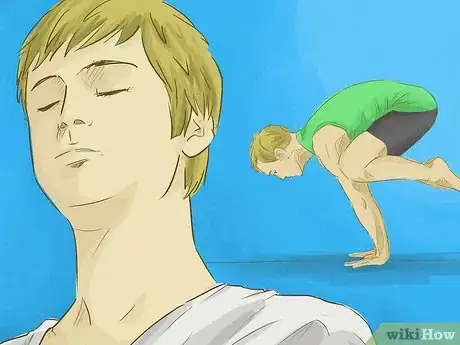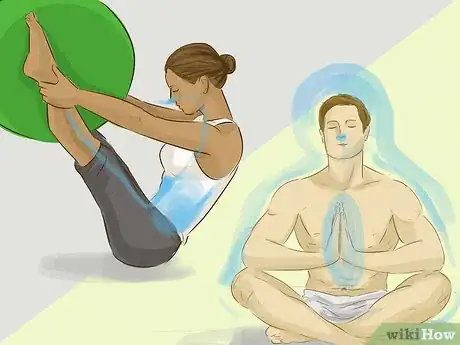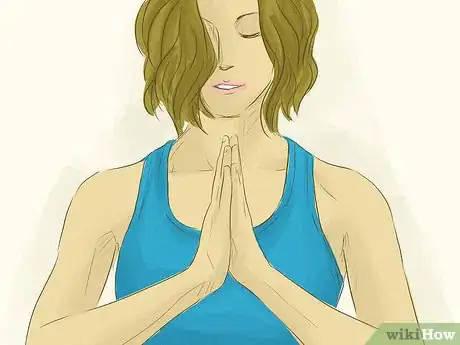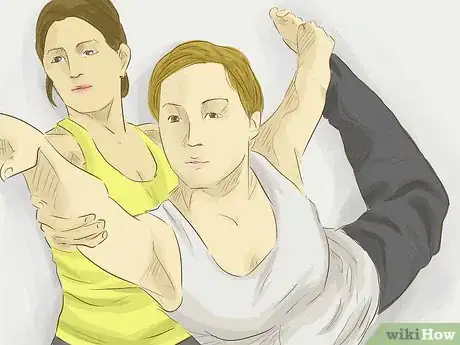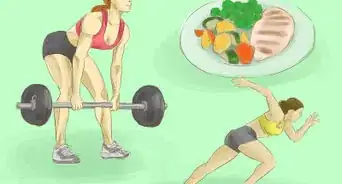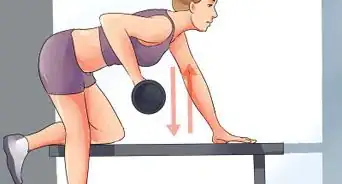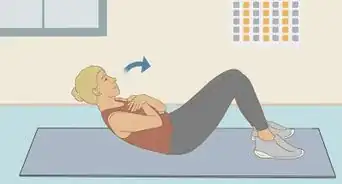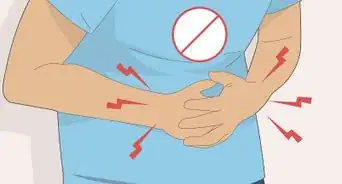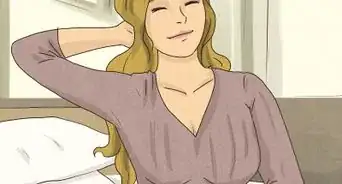This article was co-authored by Atthena Breitton, E-RYT 500. Atthena Breitton is a Yoga Alliance E-RYT 500 and Continuing Education Provider. She is the Founder & Principal Teacher of AtthenaYoga, a boutique yoga and meditation studio in New York City. She has been teaching since 2015, and some of her clients include NFL football player, Jordan Matthews, and Hip Hop Rapper, Lil Yachty. In addition to her studio, Atthena teaches and lectures around the city at major corporations such as Facebook, Ernst & Young, HSBC, U.S. Bank, and WPP. Atthena follows the path of Bhakti Yoga, a path of selfless love, devotion, and service to the Divine. Atthena holds a BS in Economics with concentrations in Finance and Management from the University of Pennsylvania.
wikiHow marks an article as reader-approved once it receives enough positive feedback. This article received 24 testimonials and 100% of readers who voted found it helpful, earning it our reader-approved status.
This article has been viewed 755,057 times.
Are you deciding whether to book yoga class or Pilates class? Are you confused about the differences between these two? There are several different factors that you should be thinking about if you are deciding which is your preferred type of exercise. You may be thinking of taking up a relatively new type of exercise and are finding it difficult to decide between yoga and Pilates. The one that you choose will become a part of your life and the decision you will make will depend on the results that you would like to attain.
Steps
Clarifying Your Goals
-
1Are you looking for physical rehabilitation? Both yoga and Pilates can offer help in rebounding physically. For example, for individuals with physical injuries, Pilates has been a tried a true method of reducing physical pain and recovering from injury.[1] Yoga, on the other hand, has been often used as part of mental and emotional rehabilitation.
- Yoga can be an excellent exercise for rehabilitation, sometimes better than pilates depending on your particular needs. A very experienced, knowledgeable yoga instructor can help you build strength and flexibility, choose exercises that fit your abilities, and how to modify exercises if you need to.
- Yoga classes can vary a lot, depending on the focus, teacher, or yoga studio. There are classes designed for chair-bound seniors in nursing homes, meditative yoga, yoga for preschoolers, and classes that Olympic-caliber athletes attend. Pilates is not quite as diverse in its presentation.
-
2Decide whether toning your body is a concern to you. Yoga and Pilates are both wonderful for toning and strengthening all of the muscles groups in your body. Pilates tends to have a greater focus on muscle toning. For example, if you are trying to lose weight, you could try Pilates exercises using different Pilates machine which add the cardio and fitness element to your Pilates poses and will help you to burn additional calories. There are no machines in yoga practice.[2]Advertisement
-
3Think about what mental health improvement you want from your exercise. Yoga has been known to have a lot of beneficial effects on mental health. Doing yoga will calm your sympathetic nervous system, helping with stress, and your hypothalamo-pituitary-adrenal axis, which controls hormone levels.EXPERT TIPAtthena Breitton is a Yoga Alliance E-RYT 500 and Continuing Education Provider. She is the Founder & Principal Teacher of AtthenaYoga, a boutique yoga and meditation studio in New York City. She has been teaching since 2015, and some of her clients include NFL football player, Jordan Matthews, and Hip Hop Rapper, Lil Yachty. In addition to her studio, Atthena teaches and lectures around the city at major corporations such as Facebook, Ernst & Young, HSBC, U.S. Bank, and WPP. Atthena follows the path of Bhakti Yoga, a path of selfless love, devotion, and service to the Divine. Atthena holds a BS in Economics with concentrations in Finance and Management from the University of Pennsylvania.Fitness Instructor

 Atthena Breitton, E-RYT 500
Atthena Breitton, E-RYT 500
Fitness InstructorOur Expert Agrees: Yoga will help you work on your balance and flexibility more than Pilates will, and you'll do a lot more twisting. In addition, yoga is great for stress relief, and it can even help you improve your focus. Even more than that, however, yoga is a spiritual practice that allows you to get in touch with yourself.
-
4Consider whether the pursuit of spirituality is something you want out of exercise. Yoga is an ancient practice that often involves exploring spirituality. Mediation is a large part of yoga. Yoga and Pilates involve the alignment of the body and the mind, but Pilates will not add focus on the spirit to this unlike yoga.[3]
- On the other hand, yoga can also be done without a large focus on spirituality, if that's not your thing. When it comes time to choose a class, if yoga interests you but spirituality does not, you can look for a more secular yoga class.
Understanding the Main Differences
-
1Read on the origins of both practices. You might find it beneficial in your deciding process to research online on the origins of yoga and Pilates.[4] Some of the main points of interest include:
- Yoga started over 5000 years ago in India. What is colloquially referred to as yoga is actually part of a larger philosophy and way of life. It was invented to promote a better understanding of oneself and the alignment of the mind, body, and spirit.
- Pilates was invented in the early 20th century as a method of body rehabilitation and strengthening. It started as a tool to rehabilitate World War I soldiers, but it took off when dancers started using it to increase their dancing performance.
-
2Evaluate the different focuses of both practices. Yoga and Pilates are similar in a lot of ways. They both include movements and poses intended to increase strength, flexibility, and the mind body connection. Ultimately though, yoga is a practice focused on your mind and how you feel, with strength and flexibility coming as a side effect. Pilates is a practice focused on toning your body and bettering your posture and movement.[5]
-
3Weigh the differences in how breath is used differently in yoga and Pilates.[6] The breathing techniques you use in Pilates and yoga differ quite a bit.
- With Pilates, the breath is used more as a technique of providing the muscles with the energy they need to exercise effectively. Concentrating on the breathing technique throughout Pilates will help you to manage the quantity of oxygen coming into the body and travelling to the muscles to help them become more relaxed.
- In yoga, the breathing exercises help you to achieve relaxation. Throughout yoga routines it is important to continuously concentrate on how the breath is being employed. Sending the breath to areas that may be tight or are holding stress can help to relax these specific muscle groups in your body.
-
4Evaluate your desire to improve your flexibility. One of the main differences between yoga and Pilates is that yoga can be used for improving the flexibility of the body and it will also gradually increase the flexibility of your joints. Stretching and holding static poses is a central theme in yoga. Pilates is more dynamic, and while flexibility will improve in Pilates, it's not a focus.[7] However, it is highly recommended to stretch after Pilates, which can improve your flexibility. Online Pilates instructors (such as Cassey Ho from Blogilates) will offer stretch videos to follow after workouts.
-
5Decide how important increasing strength is to you. Pilates focuses on trying to relax muscles which are tense and provide strengthening of the numerous muscles of the body. Unlike yoga, Pilates includes the use of resistance machines in addition to mat exercises, making it much more similar to weight training than yoga is.[8]
- Yoga and Pilates both contain several poses that are suitable for toning the abdominal muscles. However, Pilates exercises are a lot more intense and results may be achieved much quicker than they might be if practicing yoga. Through frequent Pilates exercises, a flatter and firmer stomach can be achieved.
-
6Evaluate the differences in mental benefits between yoga and pilates. Understand that yoga will focus on your mind more. Exercise has been proven helpful for individuals who are suffering from depression or anxiety. Yoga might be the most effective exercise to combat the illness because it focuses on the mind and spirit as well as the body. Quiet reflection and meditation are a large part of yoga practice. Many people start yoga with reducing stress as their main goal.
Trying Both Out
-
1Try Pilates in your home. Although it's impossible to get the full Pilates experience at home, you can get an idea of what it's like. Perhaps the best way to get started with Pilates at home is to use YouTube. YouTube has a wealth of free videos of instructors giving beginner lessons in basic Pilates exercises.[9]
- One thing you can't get out of home pilates exercise is the use of machines, so keep that in mind.
-
2Try yoga in your home. Nothing more is needed for yoga than some space and free time, which makes it a great exercise to get started with at home. You may find purchasing a mat to be helpful but it's not necessary. Search online for instructions on how to perform basic poses and postures. There are many video as well as text tutorials that will allow you to get a feel for what yoga practice is like.
-
3Look for classes near you. If you wish, you can continue to practice yoga or pilates at home, without ever stepping foot in a class. However, finding a good class might help you get the full yoga or pilates experience, and get the most out of the exercise. Search online to find classes near you. Compare the prices and the reviews. Then choose a few check out in person.
- Once you arrive at a yoga or Pilates studio you're interested in trying out, talk to the instructor about your goals and what you're looking for in a class. This will help you decide what class is right for you.
-
4Attend classes for both to decide which is best for you. If you haven't yet decided for sure whether yoga or Pilates is what you want to do, spend some time at classes for both. Look for classes that offer free trials, or free classes for newcomers. Attend a quality yoga class and a quality Pilates class a few times each and by then you should be able to make a fully informed decision on which will better serve your needs.
Comparison Chart and Basic Yoga and Pilates Moves
Expert Q&A
-
QuestionWhat are the benefits of yoga?
 Atthena Breitton, E-RYT 500Atthena Breitton is a Yoga Alliance E-RYT 500 and Continuing Education Provider. She is the Founder & Principal Teacher of AtthenaYoga, a boutique yoga and meditation studio in New York City. She has been teaching since 2015, and some of her clients include NFL football player, Jordan Matthews, and Hip Hop Rapper, Lil Yachty. In addition to her studio, Atthena teaches and lectures around the city at major corporations such as Facebook, Ernst & Young, HSBC, U.S. Bank, and WPP. Atthena follows the path of Bhakti Yoga, a path of selfless love, devotion, and service to the Divine. Atthena holds a BS in Economics with concentrations in Finance and Management from the University of Pennsylvania.
Atthena Breitton, E-RYT 500Atthena Breitton is a Yoga Alliance E-RYT 500 and Continuing Education Provider. She is the Founder & Principal Teacher of AtthenaYoga, a boutique yoga and meditation studio in New York City. She has been teaching since 2015, and some of her clients include NFL football player, Jordan Matthews, and Hip Hop Rapper, Lil Yachty. In addition to her studio, Atthena teaches and lectures around the city at major corporations such as Facebook, Ernst & Young, HSBC, U.S. Bank, and WPP. Atthena follows the path of Bhakti Yoga, a path of selfless love, devotion, and service to the Divine. Atthena holds a BS in Economics with concentrations in Finance and Management from the University of Pennsylvania.
Fitness Instructor
Warnings
- Please consult with your doctor before you take yoga and pilates class. Some of the poses may be dangerous for you if you have had surgery or suffer from any illness.⧼thumbs_response⧽
References
- ↑ https://www.wellbridge.com/fit-like-that/difference-between-yoga-and-pilates
- ↑ http://www.canadianliving.com/health/fitness/yoga_or_pilates_2.php
- ↑ http://www.active.com/fitness/articles/yoga-vs-pilates-which-one-is-right-for-you
- ↑ http://www.active.com/fitness/articles/yoga-vs-pilates-which-one-is-right-for-you
- ↑ http://www.energypilatesfitness.com/pilates-vs-yoga.html
- ↑ http://www.diffen.com/difference/Pilates_vs_Yoga
- ↑ http://www.energypilatesfitness.com/pilates-vs-yoga.html
- ↑ http://www.diffen.com/difference/Pilates_vs_Yoga
- ↑ http://www.dummies.com/how-to/content/deciding-to-try-pilates.html
About This Article
To choose between yoga and Pilates, decide what your primary fitness goals are. If you would like to increase your flexibility and improve your mental health, yoga may be the right fit. If you want to tone your body and improve your strength, Pilates may help you to better achieve your goals. To help you decide, try doing both at home or signing up for classes so you can see which one you like better. To learn more about the origins of yoga and Pilates, read on!


